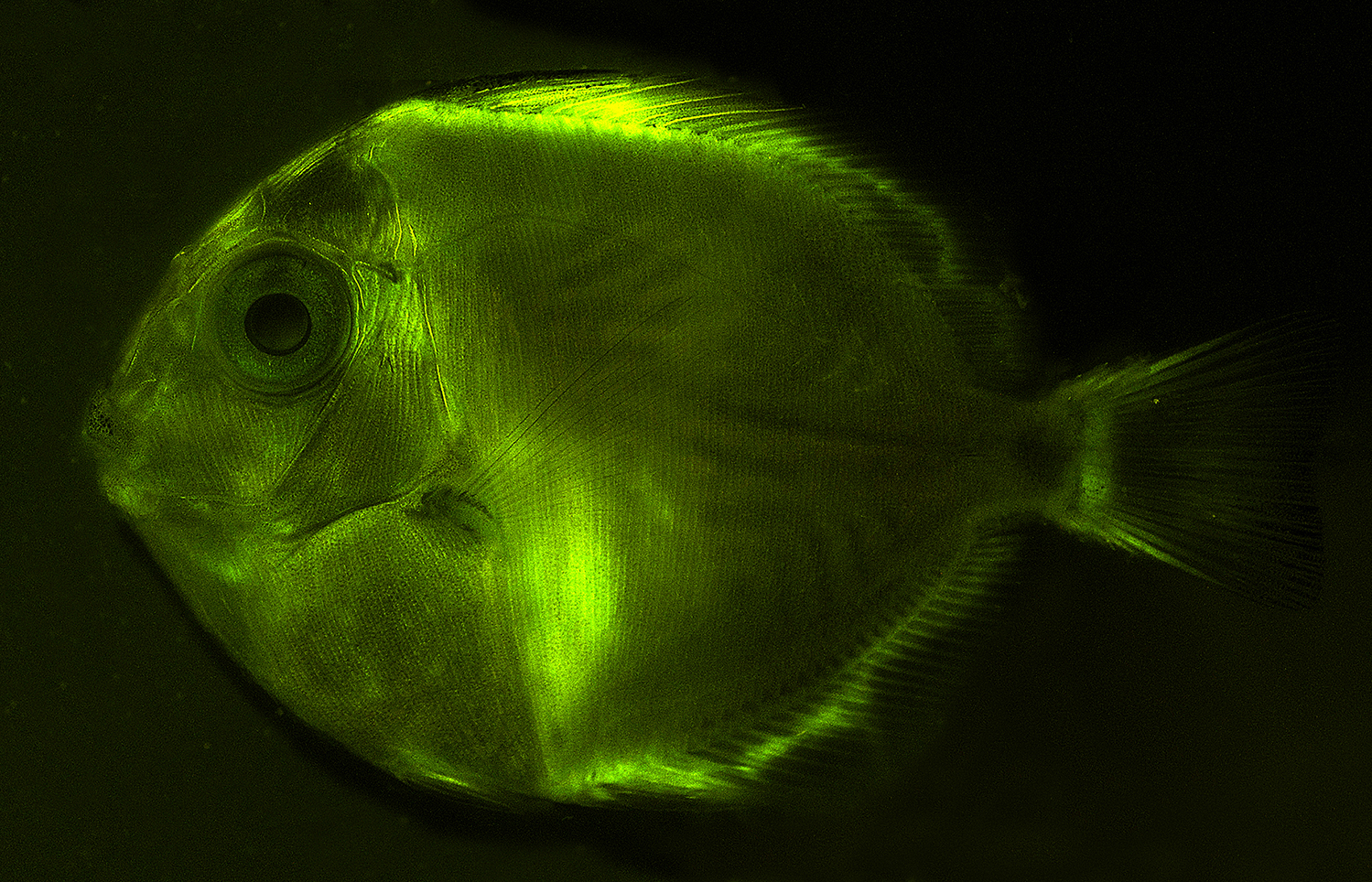Why Is This Fish Glowing Green?
Researchers have discovered an unprecedented diversity of glowing fish species.

A larval-stage surgeonfish (Acanthurus coeruleus). Surgeonfish are only biofluorescent as juveniles, according to John Sparks, curator of ichthyology at the American Museum of Natural History. The reason is unknown at this point, he says. ©AMNH
Don’t worry, the larval surgeonfish above isn’t radioactive, and it wouldn’t shock you to the core if you touched it. This fish is biofluorescing, and it’s just one of more than 180 fish species recently discovered to exhibit the phenomenon, according to a study recently published in PLOS ONE. (The research team has found more than 200 since the study came out.)
Biofluorescence has previously been observed in organisms such as coral and butterflies—and even in a few fishes—but this is the first time it’s been found across such a wide diversity of fish species, says John Sparks, curator of ichthyology at the American Museum of Natural History and co-lead author of the study. The phenomenon occurs in nature when the blue light of the ocean stimulates electrons in fluorescent proteins located within a fish’s epidermis or throughout its body. When those electrons return to their resting state, they release light at lower-energy, longer wavelengths than the sea’s azure light—and that’s when red, orange, yellow, and green fluorescence appears, says Sparks.
Biofluorescence differs from bioluminescence, which has long been acknowledged and studied in fish. “Biofluorescence requires an energy input, like sunlight or moonlight, to excite the fluorescent protein molecules,” says Sparks. On the other hand, fish species that bioluminesce do so either because of light-emitting molecules that they obtain in their diet, or because they contain bacterial colonies in specialized structures, called light organs, that themselves bioluminesce.
The researchers journeyed to Little Cayman in the Cayman Islands, the Exumas in the Bahamas, and the Solomon Islands, where they scuba-dove and sent submersibles to collect fish for imaging in water-filled tanks. The team stimulated biofluorescence in the fish by using modified or custom-built lights that matched the high-energy wavelength of the blue ocean environment (around 480 nanometers). To capture biofluorescent activity clearly, the researchers used DSLRs and ultra high-resolution cameras whose lenses were fitted with a specific filter called a longpass, which only lets through the longer wavelengths of the fish’s biofluorescent light. (See more pictures here.)
Many biofluorescent fish have filters in their eyes that probably enable them to detect biofluorescence, similar to the way that the researchers’ equipment did, says Sparks. Yet, the team isn’t sure why fish use biofluorescence in the first place, or if the proteins involved are the same across species. In the case of some fish, such as closely related lizardfish species, individuals may use biofluorescence to identify members of their own species, says Sparks. The phenomenon could also serve as camouflage, helping fish blend in with biofluorescing coral or algae. (The team plans to do more research into the function of biofluoresence in fish.)
Glowing proteins also have a range of applications beyond the sea. Green fluorescent protein, for instance, found in a certain species of jellyfish, has become an invaluable research tool in areas ranging from cell biology to neuroscience. Meanwhile, last year in the journal Cell, Japanese researchers described a fluorescent protein found in a freshwater eel that could potentially be used in liver function tests. Sparks says that part of his team is currently isolating and characterizing the glowing molecules in their newly discovered fish.
“The widespread nature of biofluorescence in marine fishes has opened up a whole new field [of research],” says Sparks. The diversity of fluorescent patterns and colors is astonishing, he says, and “The more we look, the more we find.”
Chau Tu is an associate editor at Slate Plus. She was formerly Science Friday’s story producer/reporter.